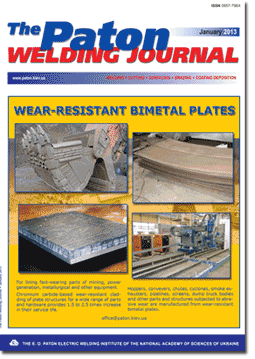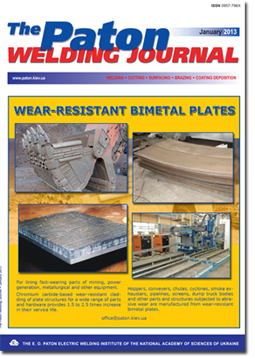| 2013 №01 (06) | 2013 №01 (08) |

The Paton Welding Journal, 2013, #1, 34-38 pages
TECHNOLOGICAL PECULIARITIES OF ELECTROSLAG NARROW-GAP WELDING OF TITANIUM
I.V. PROTOKOVILOV, V.B. POROKHONKO and D.A. PETROV
E.O. Paton Electric Welding Institute, NASU, Kiev, Ukraine
Abstract
The aim of the work consisted in development of technology for electroslag narrow-gap welding of titanium billets of 120 mm thickness using consumable nozzle, investigation of technological and metallurgy peculiarities of the process and formation of welded joint. The billets of commercial titanium VT1 of the size 120 x 120 x 270 mm were subjected to welding. The consumable nozzles of commercial titanium with two channels for electrode wires of 5 mm diameter were applied. As a slag, the flux AN-T4 was applied. The experiments were realized with the standard size of a gap between the edges of 30 mm and 22 mm into a narrow gap. The modes of welding processes, thermal cycles, macrosections of welded joints and parameters of molten metal pool were analyzed. The results of experiments showed that decrease of welding gap results in increase of welding speed by 13 %, decrease of specific energy input of the process by 23 % and reduction in area of heat-affected zone. The penetration of the edges being welded is decreased on average from 12 to 5.5 mm (by 54 %). The investigation of parameters of molten metal pool showed that width of a pool in electroslag narrow-gap welding decreased from 54 to 33 mm, at decrease of depth of a pool from 22 to 19 mm. According to the results of investigations the technology was developed and the modes of electroslag narrow gap welding of titanium were recommended providing the stable running of the process with a good formation of welded joint, without lacks of penetration, pores, cracks and other defects. 10 Ref., 1 Table, 9 Figures.
Keywords: electroslag welding, narrow gap, titanium, thermal cycle of welding, weld metal, macrostructure, weld pool
Received: 15.10.12
Published: 28.01.12
References
1. Kompan, Ya.Yu., Grabin, V.F., Abralov, M.A. et al. (1975) Electroslag welding of titanium alloys. Tashkent: Fan.
2. Kompan, Ya.Yu., Shcherbinin, E.V. (1989) Electroslag welding and melting with controlled MHD-processes. Moscow: Mashinostroenie.
3. Gurevich, S.M. (1990) Reference book on welding of non-ferrous metals. 2nd ed. Kiev: Naukova Dumka.
4. Zamkov, V.N., Lychko, I.I., Topolsky, V.F. (1999) ESW of plates of grade 5 titanium alloy. Avtomatich. Svarka, 9, 73-75.
5. Protokovilov, I.V., Porokhonko, V.B. (2012) Control of formation of welded joints in ESW (Review). The Paton Welding J., 10, 49-54.
6. Medovar, B.I., Tsykulenko, A.K., Bogachenko, A.G. et al. (1982) Electroslag technology abroad. Kiev: Naukova Dumka.
7. Berkovich, I. (1971) Going up faster with narrow-gap electroslag welding. Weld. Eng., 11, 44-45.
8. Krishna, K. (1996) Narrow-gap improved electroslag welding for bridges. Welding in the World, 38(11), 325-335.
9. GOST 30482-97: Electroslag welding of steels. Requirements to technological processes. Moscow: Standart.
10. Iliin, A.A., Kolachyov, B.A., Polkin, I.S. (2009) Titanium alloys. Composition, structure, properties: Refer. Book. Moscow: VILS-MATI.
Suggested Citation
I.V. PROTOKOVILOV, V.B. POROKHONKO and D.A. PETROV (2013) TECHNOLOGICAL PECULIARITIES OF ELECTROSLAG NARROW-GAP WELDING OF TITANIUM. The Paton Welding J., 01, 34-38.The cost of subscription/purchase order journals or individual articles
| Journal/Currency | Annual Set | 1 issue printed |
1 issue |
one article |
| TPWJ/USD | 384 $ | 32 $ | 26 $ | 13 $ |
| TPWJ/EUR | 348 € | 29 € | 24 € | 12 € |
| TPWJ/UAH | 7200 UAH | 600 UAH | 600 UAH | 280 UAH |
| AS/UAH | 1800 UAH | 300 UAH | 300 UAH | 150 UAH |
| AS/USD | 192 $ | 32 $ | 26 $ | 13 $ |
| AS/EUR | 180 € | 30 € | 25 € | 12 € |
| SEM/UAH | 1200 UAH | 300 UAH | 300 UAH | 150 UAH |
| SEM/USD | 128 $ | 32 $ | 26 $ | 13 $ |
| SEM/EUR | 120 € | 30 € | 25 € | 12 € |
| TDNK/UAH | 1200 UAH | 300 UAH | 300 UAH | 150 UAH |
| TDNK/USD | 128 $ | 32 $ | 26 $ | 13 $ |
| TDNK/EUR | 120 € | 30 € | 25 € | 15 € |
AS = «Automatic Welding» - 6 issues per year;
TPWJ = «PATON WELDING JOURNAL» - 12 issues per year;
SEM = «Electrometallurgy Today» - 4 issues per year;
TDNK = «Technical Diagnostics and Non-Destructive Testing» - 4 issues per year.


